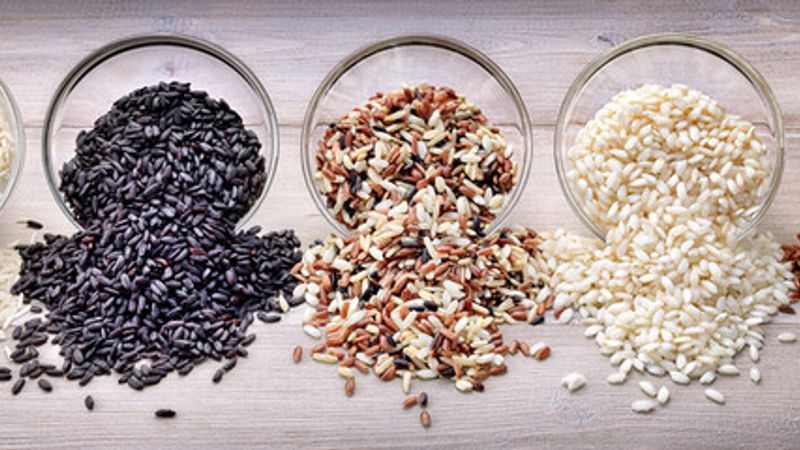

Our Review Process
Our articles undergo extensive medical review by board-certified practitioners to confirm that all factual inferences with respect to medical conditions, symptoms, treatments, and protocols are legitimate, canonical, and adhere to current guidelines and the latest discoveries. Read more.
Our Editorial Team
Shifa Fatima, MSc.
Author
Dr. Apoorva T, MHM.
MEDICAL ADVISOR
Rice and Blood Sugar
Table of Contents
Rice and Blood Sugar
Rice is a form of carbohydrate, and one of the most common forms of food grains consumed regularly by Indians, all year round. Rice comprises forms around 70% of an average human being’s calorie intake. Considering the prevalence of high blood sugar levels among people in the current times, it is important that we decipher a valid connection between the two, if at all.

White Rice vs. Brown Rice
Rice that is polished and processed, also known as white rice, is a high glycemic index (GI) food (GI - >80) which causes a is responsible for a spike in the blood sugar levels. Also, polishing and processing removes the outer bran layer from the rice, leaving only the endosperm. This milling process deprives the consumers of the outer bran layer, and hence, the crucial nutrients that are associated with it (most notably, thiamine or Vitamin B1).
Rice that is unpolished, does not undergo the milling and processing, that allows it to retain the outer bran layer. This type form of rice is known as brown rice (also grown as black and red rice in some areas).
Unpolished rice in rice, most commonly consumed as brown rice in the country, is lower in GI than white rice (GI~50). It also has a healthy amount of fibre which is necessary to ensure easy digestion, a greater feeling of satiation on consumption, and it also slowly increases blood sugar levels in a sustained manner, as compared to white rice.
For this reason, it is more advisable for people detected with high blood sugar levels or clinically diagnosed with diabetes. Brown rice, when taken in moderation, adds to the amount of fibre and minerals, along with complex carbohydrates to facilitate a healthy digestive process and to keep one energetic throughout the day. Also Read this blog to know which is the best diet?
GI of Rice
White rice (GI = 79.6) was shown to have a considerably higher glycemic index (GI) than brown rice (GI = 57.6) in a recent study by Shobhana et al. (P 0.01). [16] Researchers came to the conclusion that increased glycemic reactions occur when rice undergoes any sort of polishing.

General Health & Nutritional Benefits of Brown Rice
Unpolished (brown) rice contains the bran, germ and the endosperm. The bran is rich in nutrition with 80% of the nutrients including important minerals. The germ contains vitamin E, minerals, unsaturated fats, antioxidants, and phytochemicals.
One half-cup (100 gram) serving of cooked, long-grain brown rice contains,
- 108 KCal
- 3 grams of Protein
- 1 gram of Fat
- 22 grams of Carbohydrates
- 2 grams of Fibre
- Important minerals like Calcium, Iron, Manganese, Magnesium, Phosphorus, Selenium, & crucial vitamins like Vitamin B1 (thiamine), Vitamin B6 (pyridoxine)
With its combination of antioxidants, vitamins and minerals, brown rice plays a protective role against heart disease, cholesterol levels, digestive disorders and oxidative stress. The protective role of unpolished, brown rice against heart diseases has been scientifically shown, by at least 16-21% in clinical studies. Important plant-based antioxidants and phytochemicals help in reducing risks of inflammation and cancer, respectively. As its rich in fiber, Being rich in fiber, eating brown rice also reduced waist size measurements in obese women, implying its role in weight loss as well.
Benefits of Brown Rice in Type 2 Diabetes
Is brown rice good for diabetics? A lot of you might be wondering It may often come across in our minds if people with diabetes may benefit from substituting white rice with brown rice. It is indeed beneficial and has been shown scientifically. The answer to that is - yes! And over the years, science has gone on to make us aware of its various benefits.
A group of researchers conducted three large scale studies among 39,765 men and 157,463 women, namely the Health Professionals Follow-Up Study and the Nurses’ Health Study I and II, respectively.. After On adjusting for age and other lifestyle and dietary risk factors, the study analysis showed that people who consumed five or more servings of white rice per week were prone to a 17% increase in the risk of developing type 2 diabetes, as compared to people who ate less than one serving per month.
Can brown rice cause diabetes? Another striking feature of these studies was that it showed eating two or more servings of brown rice each week was associated with an 11% reduction in the risk of developing type 2 diabetes, compared to eating less than one serving of brown rice per month. Hence, it can be safely said that brown rice is a better source of dietary carbohydrate for people with high blood sugar or with clinically diagnosed type 2 diabetes.
How to have Brown Rice : Portion Sizes
Although white rice and brown rice contain the same number of calories and carbohydrates, it should be remembered that portion sizes play a big role in increased blood sugar levels. Also, brown rice contains higher amounts of arsenic as compared to white rice, along with anti-nutrients (phytic acid) which may slow absorption rates of zinc and iron from food in the intestines. An excess of anything is bad and so is the case with brown rice.
However, having a portion of brown rice on a daily basis has beneficial effects on health. Ideal portions are determined by dieticians, but having a moderate consumption (ranging between 1-3 cups) is acceptable and does not cause any harmful effects. People with diabetes may also have the same amount of brown rice. Read more about is brown rice good for diabetics.
How to Cook Brown Rice
Brown rice takes a higher time to boil, and soaking it beforehand might be a better idea when planning to cook. However, a beneficial hack in this case would be to cook the rice on the day before consumption, and refrigerate it after it cools down. Keep it overnight, and then have it the next day. This practice It has been proven to reduce spikes in blood sugar levels.
Bottomline
Brown rice is nutritionally rich in comparison to white rice and this should be the only consideration while making a shift. shifting from white rice to brown rice. For people living with type 2 diabetes or with a predominantly high level of blood sugar, brown rice brings in the goodness of being a whole grain that's rich in fibre, antioxidants and minerals, and a lower GI as compared to white rice. However, brown rice also contains higher amounts of arsenic and anti-nutrients as compared to white rice and thus, it should be consumed in moderation. Brown rice also keeps hunger pangs at bay and causes a comparatively lower spike in blood glucose levels, especially when consumed a day after preparation.
References
- https://www.webmd.com/diabetes/news/20100614/brown-rice-vs-white-rice-which-is-better#:~:text=Brown%20Rice%20Reduces%20Diabetes%20Risk&text=But%20eating%20two%20or%20more,brown%20rice%2C%20the%20researchers%20say.
Disclaimer
This website's content is provided only for educational reasons and is not meant to be a replacement for professional medical advice. Due to individual differences, the reader should contact their physician to decide whether the material is applicable to their case.








